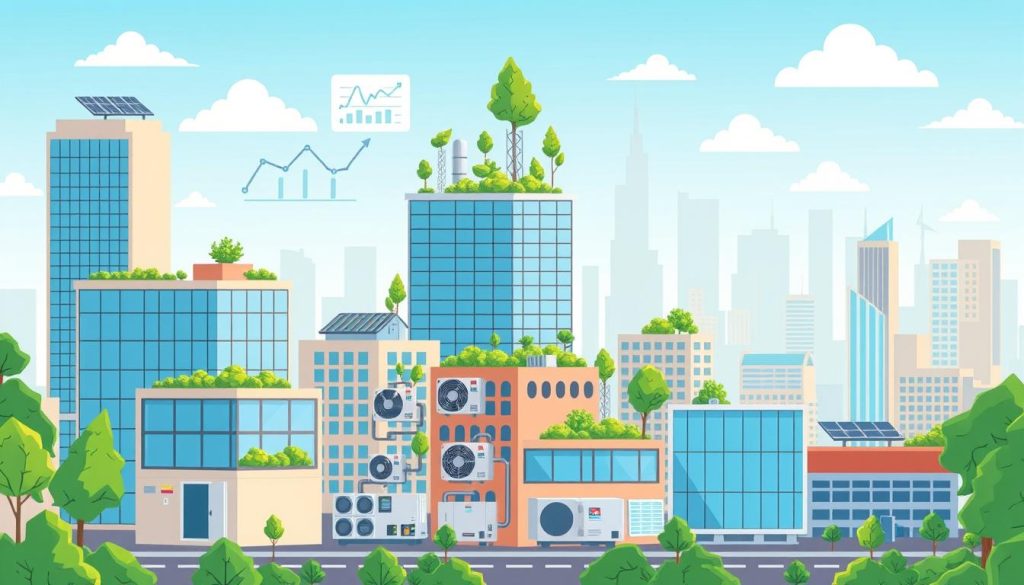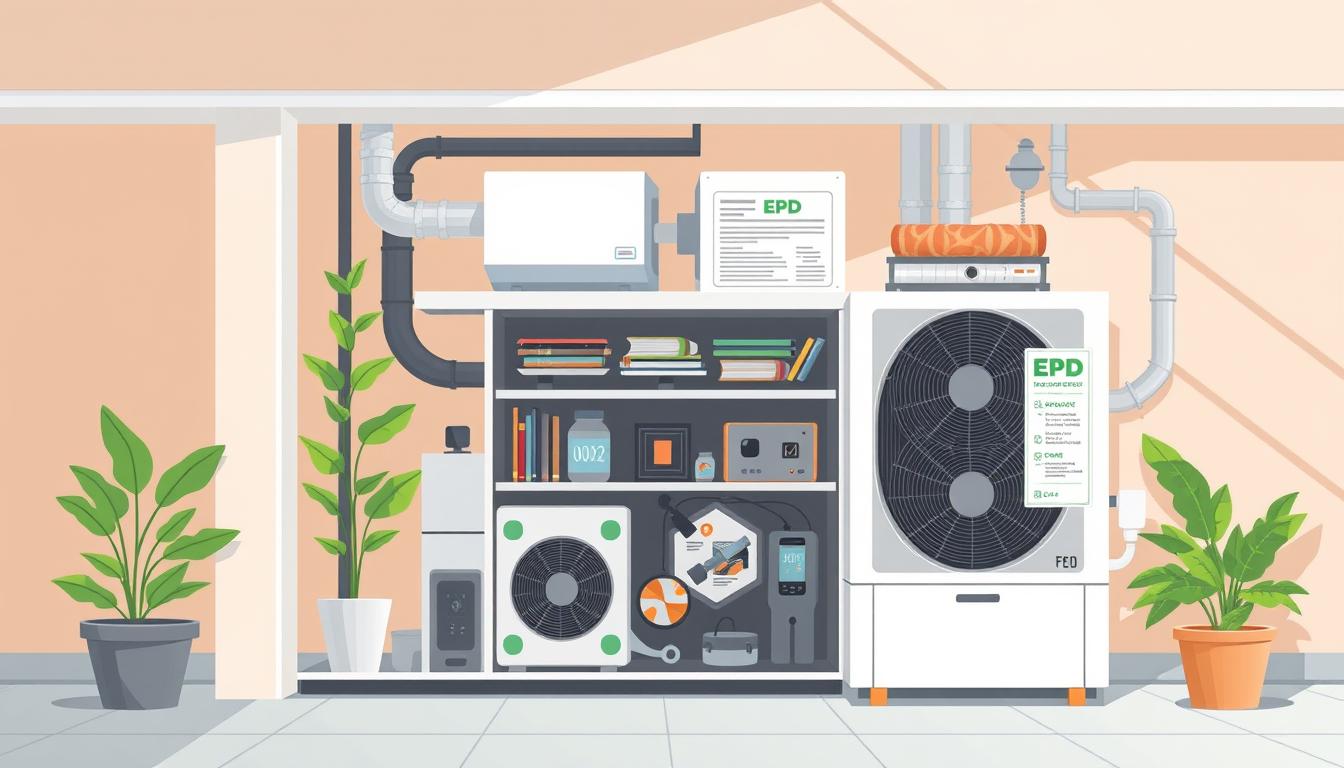If you own, design, or build buildings, you might have heard about Environmental Product Declarations (EPDs). They’re becoming key in the heating, ventilation, and air conditioning (HVAC) field. But what’s an EPD, and why is it important for HVAC systems and parts? Let’s look into the role of EPDs in HVAC.
Key Takeaways
- An EPD is an independently verified document that provides transparent information about the environmental impact of HVAC products throughout their life cycle.
- EPDs are based on comprehensive Life Cycle Assessments (LCAs) that evaluate the environmental performance of HVAC equipment and components.
- EPDs are becoming increasingly important as building owners, designers, and contractors seek to make more sustainable choices for their HVAC systems.
- EPDs can help you compare the environmental performance of different HVAC products and make informed decisions that support your sustainability goals.
- Understanding the EPD certification process and how to interpret the results can empower you to make more environmentally conscious HVAC selections.
Introduction to Environmental Product Declarations (EPDs)
Environmental Product Declarations, or EPDs, are detailed reports that show a product’s environmental impact. They cover the whole life cycle of a product. EPDs are based on the ISO 14025 standard for Type III environmental declarations. They use a Life Cycle Assessment (LCA) to give clear, comparable info on a product’s environmental performance.
Definition and Purpose of EPDs
An EPD is a detailed report that shows a product’s environmental impact. It covers everything from raw material extraction to disposal or recycling. The main goal of an EPD is to help building owners, designers, and contractors make better choices. This is especially important in the construction industry, thanks to the European Construction Product Regulation (CPR).
EPDs are based on the ISO 14025 standard. This standard makes sure the LCA data is reliable and consistent. It allows for easy comparisons between similar products.
| Key Aspects of EPDs | Description |
|---|---|
| EPD Definition | A standardized, third-party verified document that communicates the environmental impact of a product throughout its life cycle. |
| EPD Purpose | To provide transparent and comparable information about a product’s environmental performance, enabling sustainable decision-making in the construction industry. |
| ISO 14025 | The international standard that outlines the requirements for Type III environmental declarations, such as EPDs. |
| Type III Environmental Declaration | A comprehensive report on the environmental impact of a product, based on an LCA, that allows for direct comparisons between similar products. |
| Construction Product Regulation (CPR) | A European Union regulation that has driven the adoption of EPDs for building materials and components, including HVAC equipment. |
| Sustainable Building | The practice of designing, constructing, and operating buildings in an environmentally responsible and resource-efficient manner. |
Importance of EPDs in the HVAC Industry
Environmental Product Declarations (EPDs) are key in the HVAC world. They help building owners and designers cut down environmental harm. EPDs give verified data on HVAC products’ life-cycle impact. This data can help earn points in green building schemes like LEED, BREEAM, and DGNB.
Using HVAC products with EPDs shows a commitment to HVAC sustainability. It meets strict environmental rules set by local or national codes. This reduces HVAC environmental impact and meets eco-friendly building demands.
EPDs help building pros choose the greenest HVAC equipment. This choice lowers environmental footprint. It boosts the built environment’s sustainability and supports green building certification goals.
The Role of EPDs in Green Building Certification
EPDs are vital for green building certifications like LEED, BREEAM, and DGNB. These certifications need products with verified environmental data. EPDs give the needed info to score points for a higher rating.
Using HVAC products with EPDs shows a team’s dedication to sustainability. It meets the tough environmental standards of these certifications. This boosts the building’s sustainability, value, and appeal to eco-conscious tenants or owners.
Regulatory Compliance and HVAC Environmental Impact
EPDs also aid in meeting environmental regulations. As laws and standards tighten, EPDs offer the data needed for compliance. This helps HVAC manufacturers and professionals stay ahead of environmental rules.
By tackling environmental issues early and using EPDs, HVAC companies lead the industry. They ensure their products and operations are sustainable for the long haul.
Life Cycle Assessment (LCA) and EPDs
Environmental Product Declarations (EPDs) are based on a detailed Life Cycle Assessment (LCA). This assessment looks at the environmental impact of a product from start to finish. The LCA follows ISO 14040 and ISO 14044 standards. For construction products, EN 15804 and EN 15978 give extra guidance.
Understanding the LCA Process
The LCA looks at the environmental impact of getting raw materials, making the product, moving it, setting it up, using it, and getting rid of it. Important environmental impact indicators, like carbon emissions, are measured and shared in the EPD. This way, HVAC products’ environmental performance is checked in a complete and clear way.
The LCA process includes several steps:
- Goal and Scope Definition: Set the purpose, limits, and detail level for the assessment.
- Inventory Analysis: Gather data on the inputs (raw materials, energy) and outputs (emissions, waste) for each life cycle stage.
- Impact Assessment: Look at the environmental impacts of inputs and outputs, like greenhouse gas emissions and resource depletion.
- Interpretation: Look at the results to find ways to improve and understand the product’s environmental performance.
By using the LCA method in EN 15804 and EN 15978, EPDs offer a consistent and trustworthy way to share the environmental impact indicators of HVAC products at all life cycle stages.
| Life Cycle Stage | Environmental Impact Indicators |
|---|---|
| Raw Material Extraction | Carbon emissions, resource depletion, ecosystem damage |
| Manufacturing | Carbon emissions, energy use, waste creation |
| Transportation | Carbon emissions, air pollution |
| Installation | Waste creation, energy use |
| Use | Carbon emissions, energy use |
| End-of-Life | Carbon emissions, waste management, resource recovery |
By knowing the LCA process and the environmental impact indicators in EPDs, HVAC industry people can make better choices to make their products and projects more sustainable.
What is the EPD in HVAC?
In the HVAC world, Environmental Product Declarations (EPDs) are key. They give detailed info on the environmental impact of HVAC products and parts. This includes everything from raw material extraction to end-of-life disposal or recycling.
EPDs help building owners and designers choose HVAC equipment that fits their green goals. They provide a clear way to see how different HVAC components, like air conditioning and refrigeration, affect the environment.
Key Information Provided by HVAC EPDs
- Detailed environmental impact assessment across the entire product life cycle
- Quantification of resource use, energy consumption, and emissions for HVAC products
- Identification of opportunities for improvement in HVAC product design and manufacturing
- Comparison of environmental performance between different HVAC models and brands
- Valuable data for building owners and designers to make sustainable HVAC choices
Using HVAC EPDs, the industry can innovate and be more eco-friendly. This helps create a greener built environment.
| HVAC Product | Energy Consumption (kWh/year) | Carbon Footprint (kg CO2 eq/year) | Water Consumption (L/year) |
|---|---|---|---|
| Air Conditioner (8,000 BTU) | 800 | 400 | 500 |
| Heat Pump (12,000 BTU) | 1,200 | 550 | 650 |
| Furnace (80,000 BTU) | 2,000 | 800 | 800 |
The table shows how different HVAC products affect the environment. It shows why EPDs are important for choosing sustainable HVAC options.
Benefits of EPDs for Building Owners and Designers
Building owners and designers gain a lot by using Environmental Product Declarations (EPDs) for HVAC products. EPDs give clear, comparable info on the environmental effects of different HVAC options. This helps teams choose more sustainable and informed options.
EPDs are key for earning points in green building certifications like LEED, BREEAM, and DGNB. These schemes now ask for products with EPDs. This shows a commitment to the environment and lowers the project’s carbon footprint.
EPDs also help meet strict green rules set by local or national laws. By picking HVAC products with EPDs, owners and designers show they care about the environment. This supports the goal of building sustainably.
How can EPDs help building owners and designers achieve sustainability goals?
- Provide transparent and comparable data on the environmental impact of HVAC products
- Enable building teams to make more informed and sustainable product selections
- Help earn points in green building certification schemes like LEED, BREEAM, and DGNB
- Demonstrate a commitment to environmental stewardship and reduce the overall carbon footprint
- Assist in meeting stringent sustainability requirements set by local or national regulations
What are the key benefits of using EPDs in HVAC product selection?
- Transparent and comparable environmental impact data
- Ability to earn points in green building certifications
- Demonstration of environmental responsibility
- Compliance with sustainability regulations
- Reduced overall environmental impact of the building project
Using HVAC products with EPDs helps make building projects more sustainable. It also meets the growing need for green building. This benefits the environment and boosts the building’s reputation and value, helping all involved in the long run.
EPD Certification Process
Getting an Environmental Product Declaration (EPD) for an HVAC product is a detailed process. It makes sure the environmental claims of manufacturers are true and trustworthy. Let’s look at the main steps in getting an EPD.
Life Cycle Assessment (LCA) and Data Collection
The first step is to do a thorough Life Cycle Assessment (LCA) of the HVAC product. This LCA looks at the environmental impact of the product from start to finish. It includes everything from getting raw materials to recycling or disposing of it at the end.
During this step, manufacturers need to collect lots of information. This includes the product’s materials, how much energy it uses, and how it’s transported. All these details are important for the LCA.
Third-Party Verification
After collecting the LCA data, it needs to be checked by an independent group. This group could be Underwriters Laboratories (UL) or the International EPD System. They make sure the data is right and follows the ISO 14025 standard for Type III environmental declarations.
EPD Program Operators
Once the data is verified, the EPD is given out by a certified EPD program operator. These operators, like UL or the International EPD System, make sure the EPD info is clear and easy to find. They help building owners, designers, and contractors get the information they need.
The EPD certification process is key for showing the environmental facts about HVAC products. By going through these steps, manufacturers show they care about the planet. This helps building pros make better choices.

Comparing EPDs and Interpreting Results
When looking at environmental product declarations (EPDs) for HVAC products, it’s key to know the challenges. EPDs can vary due to different assumptions, system boundaries, and product category rules (PCRs). This makes direct comparisons hard. Also, EPDs might not cover all life-cycle stages, like the use phase, which affects a product’s environmental performance.
To make fair comparisons, building owners and designers must carefully look at the EPD details. They need to grasp the assumptions and see how the product fits into the whole HVAC system. It’s also vital to look at the environmental impact indicators like carbon emissions, not just one number.
What factors can make EPD comparisons challenging?
- Varying system boundaries and assumptions used in the EPD
- Differences in product category rules (PCRs) between EPDs
- Incomplete life-cycle stages, such as the use phase, in some EPDs
How can building owners and designers interpret EPD results effectively?
- Carefully review the EPD documentation to understand the underlying assumptions and methodology
- Assess the environmental impact indicators reported in the EPD, not just a single metric
- Consider the product’s system-level performance within the overall HVAC system
By grasping the details of EPD comparisons and looking at the results as a whole, building owners and designers can make better choices. This leads to better environmental impact in their projects.
Industry Initiatives and Adoption of EPDs
The HVAC industry is pushing for more Environmental Product Declarations (EPDs) through various efforts. EPD program operators like the International EPD System and the Norwegian EPD Foundation are working together. They aim to harmonize standards and practices across the industry.
They are creating complementary Product Category Rules (cPCRs) for specific products, like ventilation equipment. This helps guide manufacturers in their EPD development.
Groups like the ECO Platform are working to align EPD practices in Europe. This makes EPD data more comparable and accessible. As EPDs gain traction, manufacturers are investing in their EPDs. They are also exploring semi-automated “EPD generators” to make the process easier.
Harmonization of EPD Standards
The harmonization of EPD standards is key to widespread EPD adoption in the HVAC industry. By aligning EPD standards and practices, manufacturers can compare their products’ environmental impact more easily. This helps building owners and designers make better choices when selecting HVAC equipment.
The EN 15804 standard, developed by the European Committee for Standardization, is widely recognized. It provides a common framework for EPD development. This standard outlines the rules for life cycle assessment and environmental reporting for construction products, including HVAC equipment.
As the industry adopts and standardizes EPDs more, they will become even more valuable. They will help building owners and designers reduce the environmental impact of their HVAC systems.

Future Trends and Implications for HVAC Manufacturers
The demand for green buildings is rising fast. This means Environmental Product Declarations (EPDs) will play a bigger role in the HVAC world. HVAC makers will need to provide EPDs for their products. This is because building owners and designers want equipment that’s good for the planet and helps get green building certifications.
This change will push HVAC makers to do more Life Cycle Assessments (LCAs) and get EPD certifications. They’ll need to gather lots of data and get it checked by outside experts. Also, making EPD standards the same and creating new Product Category Rules (cPCRs) will help manufacturers make and compare EPDs more easily.
To keep up with these future EPD trends, HVAC makers should start making EPDs for their products. They should also look for new ways to make getting certified easier. Plus, they should focus on making sustainable, energy-efficient HVAC systems. These systems should offer real environmental benefits.
This won’t just help HVAC makers follow environmental regulations and meet green building standards. It will also push them to innovate and improve their market position.
How will EPDs impact HVAC manufacturer strategy?
As EPDs become more common in HVAC, makers will have to change their plans. They might invest in better LCA processes, make data collection easier, and work with groups to make EPD standards the same. This will help them meet the market’s new needs.
What are the key benefits of HVAC manufacturers adopting EPDs?
HVAC makers who start using EPDs early can gain a lot. They’ll:
- Make their products more sustainable and better for the environment
- Be more open and trusted by building owners and designers
- Follow environmental regulations and green building standards better
- Have chances to innovate and stand out in the market
How can HVAC manufacturers navigate the EPD certification process?
Getting EPD certified can be tricky, but HVAC makers can make it easier. They can use industry help, work with outside verifiers, and learn about LCA and EPD making themselves.
| Key Consideration | Implication for HVAC Manufacturers |
|---|---|
| Increasing Demand for Sustainable HVAC Solutions | HVAC makers need to focus on EPDs to stay competitive and meet new building needs. |
| Harmonization of EPD Standards | Having the same EPD standards will make getting certified easier and help compare products better. |
| Focus on Life Cycle Assessments | HVAC makers should invest in good LCA processes to get the data needed for EPDs. |
Conclusion
Environmental Product Declarations (EPDs) are key for the HVAC industry. They help building owners and designers cut down on environmental harm. EPDs give clear, verified info on HVAC products’ life-cycle impact. This lets you make choices that are better for the planet.
Knowing the EPD of HVAC parts helps you earn points for green building certifications. It also meets tough environmental rules. This way, you can pick products that fit your green goals.
As the HVAC world focuses more on being green, EPDs will become even more important. This will push manufacturers to do more Life Cycle Assessments. They’ll also work on making the EPD process easier.
EPDs are essential for the HVAC industry’s shift to greener, energy-saving systems. These systems can greatly lower a building’s carbon footprint. By using EPDs, you help create a more sustainable future. You also make better choices for your projects and push the HVAC industry to be more eco-friendly.





0 Comments